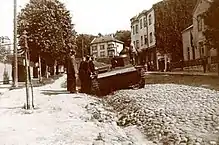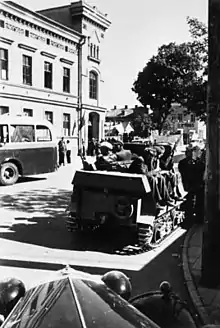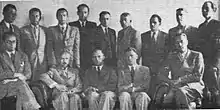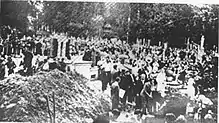Lithuanian Activist Front
Lithuanian Activist Front or LAF (Lithuanian: Lietuvių Aktyvistų Frontas) was a short-lived resistance organization established in 1940 after Lithuania was occupied by the Soviet Union. The goal of the organization was to liberate Lithuania and re-establish its independence. It planned and executed the June Uprising and established the short-lived Provisional Government of Lithuania. The Government self-disbanded and LAF was banned by Nazi authorities in September 1941. LAF remains controversial due to its anti-Semitic and anti-Polish positions.
Under the USSR

LAF was established on 17 November 1940.[1] Kazys Škirpa, former Lithuanian military attaché to Germany, is often credited as the founder.[1] LAF was meant to unite people of various political beliefs, who wanted to see Lithuania as an independent country, rather than as part of the Soviet Union or Nazi Germany.[2] The Berlin unit, formed by Škirpa, united mainly former Lithuanian expatriates and diplomats in Germany. It gathered representatives of most major pre-war Lithuanian factions and parties, and within LAF, the most influential were the Nationalist Unionists and the Christian Democrats.[1]
As time passed, local LAF units were formed in various Lithuanian cities. The local LAF units were organizing espionage networks.[1] The local LAF units in Lithuanian cities maintained more liberal political views than the Berlin headquarters. Lack of correspondence between the Berlin unit and Lithuanian units prevented discussions of ideology. In Germany, LAF had contact with Wilhelm Franz Canaris and Abwehr, but not the Nazi party. LAF expected that Nazi Germany would attack the Soviet Union and planned to use this occasion for their own rebellion and establishment of independent Lithuania.
On 22 April 1941, representatives of Vilnius and Kaunas branches of LAF decided on a list of members in the planned Provisional Government of Lithuania.[3] The Provisional Government was mainly formed out of Vilnius and Kaunas sections of LAF. However, two of its members, including the prime minister Kazys Škirpa, were in Germany and were later detained there. Over time, many people from this government, as well as other LAF members, were arrested, executed, or exiled by Soviet authorities.
June Uprising



Germany declared war on the Soviet Union on June 22, 1941, and the same day LAF started the June Uprising. LAF partisans aided the Germans. The next day, June 23, independence of Lithuania was declared. In whole Lithuania about 10,000 people participated in June Uprising, 700 of them were killed by retreating Soviet army. LAF freed 3,336 political prisoners, detained by the Soviets.[4] Short-handed Provisional Government took power on June 24. On June 21 four members of the government were arrested by the Soviet authorities, supposed prime minister Kazys Škirpa was put under house arrest in Berlin, and another minister was also unable to come. Juozas Ambrazevičius became the prime minister.
However, the negotiations with Germany over the recognition of Lithuania failed, as Nazi government had no interest in an independent Lithuania. General feldmarschall Walther von Brauchitsch issued a directive on June 26, 1941 to the commander of Army Group North, under which "small armed Lithuanian groups and Lithuanian police" should be disarmed and sent to the concentration camps.[5] Disarmament of LAF activists started by Wehrmacht in Kaunas on June 26 and lasted till June 28. Last LAF activists were disarmed in Zarasai and Obeliai on June 28-29. The German authorities did not use brutal force against its members. Rather, they established their own administrative structures (Reichskommissariat Ostland) and slowly deprived the government of its powers. The government lost all of its power in a few weeks, and seeing no more reason to continue work, dissolved itself on August 5, 1941. LAF as an organization remained. On September 15, it sent a memorandum About the status of Lithuania after the German Civil Administration started to operate (Apie Lietuvos būklę, vokiečių civilinei administracijai pradėjus veikti)[6] to Germany protesting against the occupation of Lithuania and expressing hopes that Germany would not extend its territory at the expense of Lithuania. In response, the Lithuanian Activist Front was banned on September 26; its property confiscated, and its leader Leonas Prapuolenis was arrested and sent to Dachau concentration camp. Other members like Pilypas Narutis-Žukauskas, Petras Paulaitis joined anti-Nazi resistance.
Controversy

The LAF is a controversial organization because of its anti-Semitic[7] and anti-Polish[1] views and overall collaboration with the Nazi Germany. For example, LAF's manifesto-type essay "What Are the Activists Fighting for?" states: "The Lithuanian Activist Front, by restoring the new Lithuania, is determined to carry out an immediate and fundamental purging of the Lithuanian nation and its land of Jews...".[8] The LAF's pro-Nazi rhetoric and stridently anti-Semitic propaganda that equated Jews with Bolshevism and was widely disseminated in Lithuania prior to and during the June uprising likely encouraged the local population to engage in mass violence against Jews that began prior to the arrival of Nazi forces in the country and continued during the Nazi occupation (1941-1945).
"It would be very important to take advantage of this occasion to get rid of the Jews. Therefore, there must be such an anti-Jewish climate in the country that not a single Jew would even dare to imagine that the Jews would have any minimal rights or any chance for subsistence in the new Lithuania. Our aim is to compel the Jews to flee Lithuania together with the Red Army troops and Russians. The more Jews abandon Lithuania under these circumstances, the easier it will be later to achieve complete liberation from the Jews. The hospitality that Vytautas the Great offered to the Jews in Lithuania has been revoked for all times for the ongoing betrayal of the Lithuanian nation." – LAF Pamphlet "Guidelines for the Liberation of Lithuania", March 1941 [9]
By some calculations, more than 95% of Lithuania's Jewish population was massacred during the Nazi occupation—a more complete destruction than befell any other country affected by the Holocaust. Historians attribute this to the massive collaboration in the genocide by the non-Jewish local paramilitaries, though the reasons for this collaboration are still debated.[10][11][12][13] The Holocaust resulted in the largest-ever loss of life in so short a period of time in the history of Lithuania.[13]


The goal of the June uprising organized by the LAF was to seize control of Lithuania as Soviet forces retreated in the face of Germany's attack. During the June uprising, LAF paramilitaries committed many atrocities (rapes, murders, pillage). Even the Germans referred to these "allies" as "organized robbers".[1] Also, a number of acts issued by the LAF-instituted Provisional Government of Lithuania discriminated against Jews, one notable example being Žydų padėties nuostatai (English: Regulation on the Status of Jews), which according to some authors were never actually adopted and only considered by the Provisional Government.[14]
Among the initial tactics of Nazi authorities was to surreptitiously encourage and involve the local population in attacks on Jews. These tactics are well disclosed in the Schutzstaffel General Brigadeführer and Security Police Chief of the Occupied Eastern Territories Franz Walter Stahlecker October 15, 1941 report to the Reich Minister Heinrich Himmler. In this report Stahlecker states that the extermination of Jews in the Wehrmacht-occupied territories should be performed in a way that the Nazis would remain "clean" and that there would be no sign of Nazis actual inspiration, organization or conducting, and it should look like that the local population and its institutions in their own initiative performed the execution of the Jewish population.[15][16][17][18] In this regard, the LAF and its paramilitaries initially proved handy. But later Stahlecker complained that it was "not a simple matter" to organize Lithuanians into actions against Jews.[17][19]
Meanwhile, the LAF-established Provisional Government of Lithuania did little to oppose the anti-Jewish violence and murder carried out by the Nazis and their local collaborators. Its main goal was to protect ethnic Lithuanians and reestablish an independent Lithuania under the patronage of Nazi Germany. Ministers expressed distress at the atrocities being committed against the Jews, but advised only that "despite all the measures which must be taken against the Jews for their Communist activity and harm done to the German Army, partisans and individuals should avoid public executions of Jews."[20] According to Lithuanian-American Holocaust historian Saulius Sužiedėlis, "none of this amounted to a public scolding which alone could have persuaded at least some of the Lithuanians who had volunteered or been co-opted into participating in the killings to rethink their behavior."[21]
The Lithuanian TDA Battalions, military units of the Provisional Government, were soon taken over by Nazi officials and reorganized into the Lithuanian Auxiliary Police Battalions (Lithuanian version of Schutzmannschaft).[22] The original TDA eventually became the 12th and the 13th Police Battalions. These two units took an active role in mass killings of the Jews in Lithuania and Belarus.[23] Based on the Jäger Report, members of TDA murdered about 26,000 Jews between July and December 1941.[24]
Later Juozas Ambrazevičius actively participated in the anti-Nazi underground, four members of the Provisional Government were imprisoned in the Nazi concentration camps.[25] There are allegations by certain journalists that, in 1973, a Committee of the United States Congress made conclusions that Prime Minister of the Provisional Government Juozas Ambrazevičius' and Jonas Šlepetys' were not responsible for the the Holocaust in Lithuania.[26][27][28] However, according to a subsequent clarification issued in 2019 by the Foreign Affairs Committee of the US Congress, the investigation was not conclusive and did not amount to a "rehabilitation" of Ambrazevičius/Brazaitis. The investigation into his wartime activities was discontinued after Ambrazevičius/Brazaitis passed away in 1974.[29]
References
- Tadeusz Piotrowski, Poland's Holocaust, McFarland & Company, 1997, ISBN 0-7864-0371-3, Google Print, pp. 163-168
- Bradley Campbell, The Geometry of Genocide: A Study in Pure Sociology, University of Virginia Press, 2015, ISBN 978-08-13-93742-7, p. 179.
- Sigitas Jegelevičius. 1941 m. Lietuvos laikinosios vyriausybės atsiradimo aplinkybės (Circumstances of establishing provisional government of Lithuania in 1941), Voruta, No. 11 (557), June 11, 2004 Archived May 7, 2006, at the Wayback Machine
- Tamakauskas, Zigmas. "1941 metų Birželio sukilimo žingsnių aidas" (in Lithuanian). Retrieved 13 October 2019.
- Vitkus, Zigma. "Sigitas Jegelevičius: "Birželio sukilimą šiandien dažnai matome pro sovietinės propagandos akinius" (I)" (in Lithuanian). Retrieved 6 October 2019.
- "Kai kurie slapto ir viešo Pasipriešinimo bruožai 1940-1942m. dokumentuose - ANTINACINĖ REZISTENCIJA". www.partizanai.org (in Lithuanian). Retrieved 12 October 2019.
- Sakowicz, Kazimierz (2008). Ponary Diary, 1941-1943: A Bystander's Account of a Mass Murder. Yale University Press. pp. 2–3. ISBN 9780300129175.
- "The Murder of the Jews in German-Occupied Lithuania." Paper by Yitzhak Arad delivered at the international conferences in Nida (1997) and Telsiai (2001) on "The Vanished World of Lithuanian Jews." https://books.google.com/books?id=mdXRKbcyi5oC page 191
- In Truska, Liudas and Vareikis, Vygantas. Preconditions for the Holocaust: Anti-Semitism in Lithuania: Second Half of the 19th Century–June 1941. Margi Raštai, Vilnius (2004). pp. 268–269.
- Daniel Brook, "Double Genocide. Lithuania wants to erase its ugly history of Nazi collaboration—by accusing Jewish partisans who fought the Germans of war crimes.", Slate, July 26, 2015
- Porat, Dina (2002). "The Holocaust in Lithuania: Some Unique Aspects". In David Cesarani (ed.). The Final Solution: Origins and Implementation. Routledge. pp. 161–162. ISBN 978-0-415-15232-7.
- MacQueen, Michael (1998). "The Context of Mass Destruction: Agents and Prerequisites of the Holocaust in Lithuania". Holocaust and Genocide Studies. 12 (1): 27–48. doi:10.1093/hgs/12.1.27. ISSN 8756-6583.
- Bubnys, Arūnas (2004). "Holocaust in Lithuania: An Outline of the Major Stages and Their Results". The Vanished World of Lithuanian Jews. Rodopi. pp. 218–219. ISBN 978-90-420-0850-2.
- "Dokumentas: Lietuvos žydų persekiojimas ir masinės žudynės 1941 metų vasarą ir rudenį". Bernardinai.lt. Retrieved 15 June 2012.
- Balčiūnas, J. V. "LAIKINOJI VYRIAUSYBĖ IR ŽYDAI - Sovietinė propaganda tebesinaudoja nacių talka". www.aidai.eu (in Lithuanian). Retrieved 24 December 2017.
- Zeiger, Henry A. (2015). The Case Against Adolf Eichmann. Pickle Partners Publishing. p. 66. ISBN 9781786254481.
- Friedman, Philip (1957). Their brothers' keepers. Crown Publishers. p. 136. ISBN 9780896040021.
- Friedman, Philip (1978). Their brothers' keepers. Holocaust Library. p. 136.
- "Lietuvos žydų likimas ir Laikinoji Lietuvos Vyriausybė". Partizanai.org (in Lithuanian). Retrieved 24 December 2017.
- Sužiedėlis, Saulius. "The Burden of 1941". Lituanus Lithuanian Quarterly Journal of Arts and Sciences, Volume 47, No. 4 (Winter 2001).
- Sužiedėlis, Saulius. "The Burden of 1941". Lituanus Lithuanian Quarterly Journal of Arts and Sciences, Volume 47, No. 4 (Winter 2001).
- Knezys, Stasys (2000). "Kauno karo komendantūros Tautinio darbo batalionas 1941 m." Genocidas Ir Rezistencija (in Lithuanian). 7 (1). ISSN 1392-3463.
- Atamukas, Solomonas (Winter 2001). "The Hard Long Road Toward the Truth: On the Sixtieth Anniversary of the Holocaust in Lithuania". Lituanus. 4 (47). ISSN 0024-5089.
- Bubnys, Arūnas (2004). "The Holocaust in Lithuania: An Outline of the Major Stages and Results". The Vanished World of Lithuanian Jews. Rodopi. pp. 209–210. ISBN 90-420-0850-4.
- "Kaune perlaidojami 1941-ųjų Laikinosios vyriausybės vadovo Juozo Brazaičio palaikai". 15min.lt. Retrieved 20 May 2012.
- Sinica, Vytautas. "Istorijos perrašymas: būtina skubiai pasmerkti Vincą Kudirką". LZinios.lt. Archived from the original on 7 December 2016. Retrieved 6 December 2016.
- Lukšas, Aras (2009). J. Ambrazevičius-Brazaitis—Vienų Vienas (J. Ambrazevičius-Brazaitis—Purely alone).
- Meidutė, Aistė. "Vanagaitė įkvėpė Kremlių: aukština NKVD smogikus ir vėl šmeižia partizanų vadus". DELFI.lt. Retrieved 23 July 2018.
- "JAV Kongreso laiškas premjerui: neigia išteisinę J.Ambrazevičių-Brazaitį". 15min.lt. 15 October 2019.
- 1941 m. Lietuvos laikinosios vyriausybės atsiradimo aplinkybės, Doc. dr. Sigitas Jegelevičius, Voruta, No. 11 (557), June 11, 2004
- Lietuvių aktyvistų frontas, Laikinoji Vyriausybė ir žydų klausimas, Dr. Valentinas Brandišauskas, a presentation delivered during a seminar-discussion, March 23, 1999
- Z.Ivinskis. The Lithuanian Revolt Against the Soviets in 1941